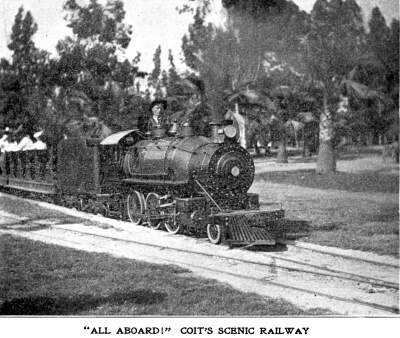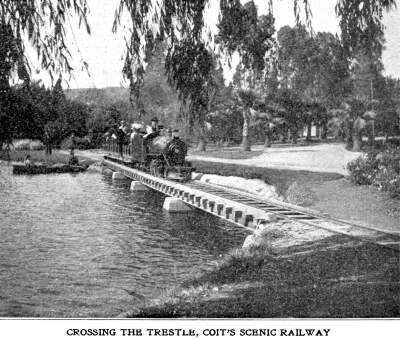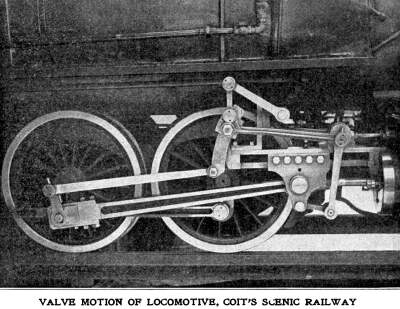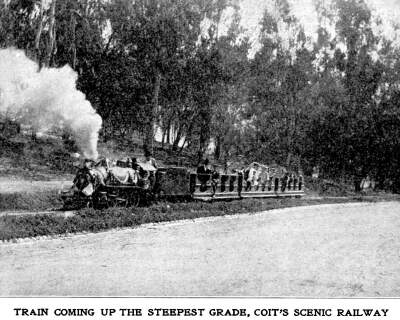|

A Miniature Scenic Railway.
Locomotive Fireman's Magazine—October,
1904
The illustrations herewith show an engine designed and built
by Bro. J. J. Colt, a member of Lodge 97, B. of L. F., who for
more than two years has been physically disabled, and is now depending
upon the earnings of his miniature railway for a living. What
Bro. Coit lacks physically, is more than offset by his unusual
mental ability and ingenuity, which is so ably shown in this perfect
little model, and the wish of all his brothers is that success
will crown his efforts, The following is a description of the
locomotive:
 Total weight of engine and tender 8,000 lbs.;
Weight of engine alone 5,134 lbs.; Total length, tip of pilot
to end of tank coupler 19 ft.; Height from top of rail to top
of stack 51 in. Total weight of engine and tender 8,000 lbs.;
Weight of engine alone 5,134 lbs.; Total length, tip of pilot
to end of tank coupler 19 ft.; Height from top of rail to top
of stack 51 in.
The boiler is of the Vanderbilt type, 25-horsepower, with a
working steam pressure of 150 pounds. Its weight is distributed
on three pairs of drivers 18¼ inches in diameter and a
pony truck, the wheels of which are 10 inches in diameter. The
cylinders are 5x7 inches, and the full stroke of the valves is
1 inch.
The engine has a drawbar pull of 1,076 pounds; the gauge of
track is 18 inches, and the capacity of the tender is 206 gallons
of water and 86 gallons of oil. The engine is equipped with many
devices of Bro. Coit's own invention, among which are a valve
motion without eccentrics which greatly simplifies valve setting,
an up-draft oil burner, upon which a patent has been applied for,
and automatic couplers for the cars and engine. The engine hauls
a train of three cars, having a seating capacity of ten persons
each, over a track abounding in curves and heavy grades, affording
to the traveler a good view of the beauties of East Lake Park.
F. C. McCARN, Lodge 97.
 A Novel Valve Motion.
A Novel Valve Motion.
November, 1904
 In the October,
1904, issue of the Magazine was illustrated and described "A
Miniature Scenic Railway," the engine and cars of which were
designed and built by Bro. J. J. Coit, a member of Lodge 97, B.
of L. F. Among the devices of Bro. Colt's invention with which
the engine is equipped is a valve motion without eccentrics, which
greatly simplifies valve setting and is easy to get at. In the October,
1904, issue of the Magazine was illustrated and described "A
Miniature Scenic Railway," the engine and cars of which were
designed and built by Bro. J. J. Coit, a member of Lodge 97, B.
of L. F. Among the devices of Bro. Colt's invention with which
the engine is equipped is a valve motion without eccentrics, which
greatly simplifies valve setting and is easy to get at.
Herewith is shown a view of the valve motion, taken at close
range from one side of the locomotive, and another view showing
the engine and train coming up the steepest grade on the line.
The bushings in all bearings of this valve motion are of case-hardened
steel, as are also the links and link blocks. The link derives
its motion from a rod and crank connected to the main pin, very
similar to the Stevens "monkey-motion" engine. This
however, has the ordinary slide valve, differing therein from
the Stevens engine.
The conveniences for oiling and disconnecting this valve motion
in case of breakdowns are apparent. It also does away with present
methods of setting valves, greatly simplifying the work.
I regret that I have been unable to secure drawings of this valve
motion, so as to convey a better idea of its construction, but
should the opportunity present itself in the future I will do
so.
F. C. McCAIN, Lodge 97.
Oddities
| Contents Page
|







